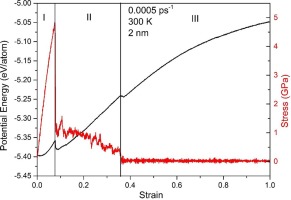当前位置:
X-MOL 学术
›
Comp. Mater. Sci.
›
论文详情
Our official English website, www.x-mol.net, welcomes your feedback! (Note: you will need to create a separate account there.)
Tensile strength and failure mechanism of hcp zirconium nanowires: Effect of diameter, temperature and strain rate
Computational Materials Science ( IF 3.3 ) Pub Date : 2020-05-01 , DOI: 10.1016/j.commatsci.2020.109551 Vildan Guder , Sedat Sengul
Computational Materials Science ( IF 3.3 ) Pub Date : 2020-05-01 , DOI: 10.1016/j.commatsci.2020.109551 Vildan Guder , Sedat Sengul

|
Abstract This study is a comprehensive analysis to demonstrate the deformation and failure mechanism of hexagonal Zr nanowires in [0 0 0 1] orientation. Molecular dynamics simulations in conjunction with embedded atom potentials are utilized to determine the effect of the temperature, diameter and strain rate on mechanical properties of nanowire. We have observed two basic scheme that these parameters have different impacts on elastic and plastic deformations of Zr nanowires. The elastic response of nanowire increases by high strain rate, low temperature and small diameter. Although Young’s Modulus can be characterized by strain rate, the temperature and the diameter are more effective key variables in engineering of strength mechanism. On the other hand, high strain rate, low temperature and large diameter decrease the failure of Zr nanowires.
中文翻译:

hcp 锆纳米线的抗拉强度和失效机制:直径、温度和应变速率的影响
摘要 本研究综合分析了[0 0 0 1]取向的六方Zr纳米线的变形和破坏机制。结合嵌入原子势的分子动力学模拟被用来确定温度、直径和应变速率对纳米线机械性能的影响。我们已经观察到两个基本方案,这些参数对 Zr 纳米线的弹性和塑性变形有不同的影响。纳米线的弹性响应因高应变率、低温和小直径而增加。虽然杨氏模量可以用应变率来表征,但温度和直径是强度机制工程中更有效的关键变量。另一方面,高应变率、低温和大直径降低了 Zr 纳米线的失效。
更新日期:2020-05-01
中文翻译:

hcp 锆纳米线的抗拉强度和失效机制:直径、温度和应变速率的影响
摘要 本研究综合分析了[0 0 0 1]取向的六方Zr纳米线的变形和破坏机制。结合嵌入原子势的分子动力学模拟被用来确定温度、直径和应变速率对纳米线机械性能的影响。我们已经观察到两个基本方案,这些参数对 Zr 纳米线的弹性和塑性变形有不同的影响。纳米线的弹性响应因高应变率、低温和小直径而增加。虽然杨氏模量可以用应变率来表征,但温度和直径是强度机制工程中更有效的关键变量。另一方面,高应变率、低温和大直径降低了 Zr 纳米线的失效。



























 京公网安备 11010802027423号
京公网安备 11010802027423号